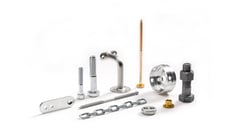- Insights
- The Solutionists Hub
- C-Parts Inventory Costs, and How to Reduce Them
C-Parts Inventory Costs, and How to Reduce Them

Managing the parts inventory is always challenging for all kinds of manufacturing companies. Keeping an optimized inventory is vital if you want to meet your KPIs and ensure the production line can keep rolling with no downtime. In this article, I’ll cover some of the hidden costs that can arise if you haven’t got a grip on your C-parts inventory and give suggestions on how to get them under control.
What are the real costs in C-parts inventories?
The costs you experience in your C-parts inventory will likely differ greatly from those faced by a colleague who is responsible for larger, higher-value, and less numerous A- and B-parts.
In those inventories, a major cost is the sheer amount of capital tied up. Therefore, if the items in the inventory have a high financial value, the company must get the stock levels right to avoid tying up more money than necessary.
Another significant cost in these kinds of inventories is the cost of storage and warehousing. If the items in the inventory are bulky, they take up a large amount of space, leading to increased costs for things like rent, heating, maintenance and handling.
Generally, these two major inventory costs aren’t so relevant for C-parts inventories. The C-parts themselves have a low financial value and tie up relatively little capital. And while a large C-parts inventory could take up a fairly large amount of floor space in your production facility, it won’t be much in comparison to multiple racks of pallets.
In my opinion, the main driver of costs around your C-parts inventory cost isn’t the inventory itself – it’s the cost of having the wrong inventory. If you’ve made bad choices with your inventory, your costs can quickly spiral across the entire organization and lead to problems that ‘insignificant’ parts like these shouldn’t cause. Let’s take a look at a few of them.
Express deliveries of C-parts
It can be difficult to completely eliminate express deliveries of C-parts. Even if your inventory is well-managed, unforeseen events can arise, and it’s great that it’s possible to get an emergency shipment of parts very quickly, even if it comes at a price. However, manufacturers with poor control over their C-parts inventory use these kinds of deliveries more often.
Express deliveries are expensive, and if they become a regular habit, they can become an uncomfortable cost. Additionally, they’re problematic from a sustainability perspective – especially if air freight or long-distance transportation is involved.
Damaged reputations among customers
This cost can be difficult to eliminate once it becomes a problem. And even though the cost is not directly related to your inventory, it’s still significant. For example, suppose you have issues with an unoptimized inventory. In that case, you’re likely to be impacted by downtime, late deliveries, and long lead times more often than competitors that have their C-parts inventories under control. In addition, if these problems occur regularly, your reputation will suffer among customers and prospective customers, impacting your business in the long term.
Downtime in production due to a lack of C-parts
Anyone who works in manufacturing knows how costly downtime and stops in production can be. These issues are incredibly embarrassing if caused by something as simple as a shortage of C-parts. Poor inventory practices, whether due to incorrect stock management, ordering issues, or inaccurate forecasting, can easily lead to downtime and quickly ramp up your costs.
Obsolescence of parts
Again, losing control over your inventory makes it much harder to create accurate forecasts. In the worst cases, this can lead to your inventory filling up with components you don’t need anymore. For example, if you’re discontinuing a product and haven’t factored this into your inventory planning, you can easily end up receiving a large shipment of components that you won’t use. This doesn’t just waste money and inflate your inventory costs unnecessarily – it’s also highly unsustainable.
The real cost of C-parts you should be concerned about
As you can see, these costs aren’t linked to the inventory itself. Of course, the cost of the components and the system you use to manage them will always have to be accounted for, but these other things can really drive costs and create problems for you and your company.
Colleagues in other parts of your organization may be more interested in how much you’re paying for your C-parts than how the inventory is managed. For many other types of goods with a higher value, getting a lower price from the supplier can lead to impressive savings. But with low-value C-parts, those same savings can easily be eaten up by a single late order or express delivery caused by an unoptimized inventory.
How you can reduce your inventory costs
All the cost-creating problems I’ve mentioned above have the same root cause – an inventory that isn’t optimized for the company’s needs. This lack of optimization leads to inventory and management practices that make accurate forecasting, planning, and analysis more difficult. At the end of the day, a situation like this will create problems in production and generally cause the kinds of headaches that C-parts shouldn’t cause.
One way to internally alleviate issues like these is to focus on improving communication within your company. For example, when the people responsible for purchasing C-parts aren’t talking to those responsible for planning, parts shortages or obsolescence can quickly occur. And when these kinds of issues aren’t shared with customer-facing departments like sales and service, they can’t communicate with the customer and manage their expectations, which leads to disappointments and damaged reputations when their orders are affected. If all of these different areas of the company have clear and open channels of communication between them, the worst misses can be avoided and inventory issues that clog up the rest of the business can be prevented.
However, some companies that have excellent communication still struggle with these problems sometimes. In my opinion, a logistics solution, also sometimes called a vendor managed inventory (VMI) solution, often works even when other options have failed. Many companies I’ve worked with have benefited from working with an external partner who has uncovered the realities around their C-parts’ needs and met them using a VMI solution. Other companies with a good overview of their inventory practices still benefit from an outside perspective, as well as lowered administrative costs in the purchasing department or ways around high supplier MOQs.
The ultimate goal with a solution like this, or any alternative, should be to make replenishment of your C-parts inventory ‘invisible’ to the rest of the organization. The phrase we always use in Bufab is “peace of mind” – the needed C-parts should always be available in the right quantity and quality whenever you need them. If this is achieved, a reliable and predictable supply of the needed C-parts will become a matter of course for your company, and you can at least remove one source of stress from your working day.
Get more inventory optimization insights
If you're planning on starting an inventory optimization project, you need to get equipped with knowledge. We give you two options:
- Visit our guide to inventory optimization to find out what it is, when you should start exploring it and some of the challenges and opportunities it will create for your organization.
- Download The Manufacturer's Guide to Logistics Solutions below, and get a description and comparison of the digital alternatives that can help you achieve peace of mind with your C-parts inventory.










